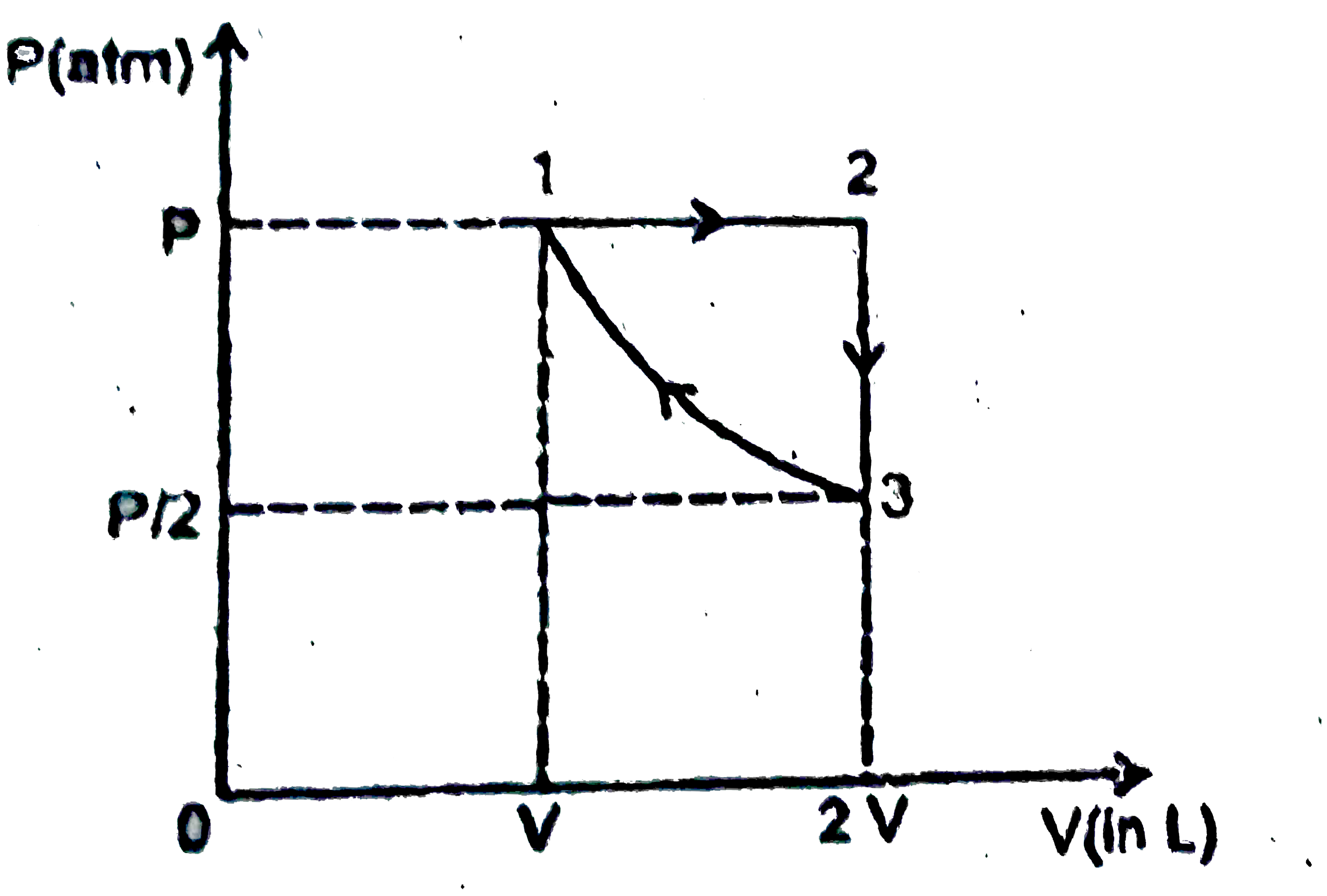Two moles of a perfect gas undergo the following processes:
(a) a reversible isobaric expansion from (1.0 atm , 20.0 L) to (1.0 atm, 40.0 L)
(b) a reversible isochroic change of state from (1.0 atm , 40.0L) to (0.5 atm , 40.0 L)
(c) a reversible isothermal compression from (0.5 atm,40.0 L ) to (1.0atm, 20.0L)
Calculate the magnitude of work (W) done in L.atm
The correct Answer is:(a) -20 L atm (b) W2=(∵)ΔV=0) (c) 6 L atm
(a) State A to state B (Isobasric expansion)
Work done by the gas =W1=−p(VB−VA)=−1(40−20)=−20Latm
(b) State B to state C (isochoric process )
Work done by the gas =W2=0.(∵ΔV=0)
(c) State C to state A (isothermal compression)
Work done on the gas =W3=−2.303nRTlogVAVC
=−2.303pVlogVAVC(pV=pAVA=pBVB=nRT=20)=−20ln(12)=20×ln(2)=14
∴ total work done by the gas
=W1+W2+W3=−20+0+14=−6Latm
Topper's Solved these Questions
- THERMODYNAMICSBOOK - RESONANCECHAPTER - THERMODYNAMICSEXERCISE - exercise-3 part-III Advanced level Solutions (STAGE-I)
6 Videos
- THERMODYNAMICSBOOK - RESONANCECHAPTER - THERMODYNAMICSEXERCISE - exercise-3 part-III Advanced level Solutions (STAGE-II)
45 Videos
- THERMODYNAMICSBOOK - RESONANCECHAPTER - THERMODYNAMICSEXERCISE - exercise-3 part-1 Advanced level Solutions
30 Videos
- TEST SERIESBOOK - RESONANCECHAPTER - TEST SERIESEXERCISE - CHEMISTRY
50 Videos
Similar Questions
Two moles of a perfect gas undergo the following processes :
(a) a reversible isobaric expansion from (1.0 atm, 20.0 L) to (1.0 atm, 40.0 L)
(b) a reversible isochoric change of state from (1.0 atm, 40.0 L) to (0.5 atm, 40.0 L)
(c ) a reversible isothermal compression from (0.5 atm, 40.0 L) to (1.0 atm, 20.0 L)
(i) Sketch the labels of each of the processes on the same p-V diagram.
(ii) Calculate the total work (W) and the total heat change (q) involved in the above processes.
(iii) What will be the values of ΔU,ΔH and ΔS for the overall process ?
View SolutionTwo moles of a perfect gas undergo the following process: (a) A reversible isobaric expansion from (1.0 atm, 20.0 litre) to (1.0 atm,40.0litre). (b) A reversible isochoric change of state from (1.0 atm, 40.0 litre) to (1.0 atm, 40.0 litre). (b) A reversible isochoric change of state from (1.0 atm, 40.0 litre) to (0.5 atm, 40.0 litre). (c) A reversible isothermal compression from (0.5atm, 40.0 litre) to (1.0 atm, 20.0 litre). (i) Sketch with labels each of the process on the same P−V diagram. (ii) Calculate the total work (W) and the total heat change (q) involved in the above process. (iii) What will be the value of ΔU,ΔH and ΔS for the overall process?
View Solution
Knowledge Check
Two moles of an ideal gas undergo the following process :
(a) a reversible isobaric expansion from (P atm, VL) to (P atm , 2VL).
(b) a reversible isochoric change of state from (P atm , 2V,L) to (P/2 atm, 2VL)
(c) a reversible isothermal compression from (P/2 atm, 2VL) to (P atm, VL).
Sketch with labels each of the processes on the same P−V diagram.A B
B C
C D
D
Maximum heat absorbed during isothermal expansion of an ideal gas from (10 atm, 1 L) to (1 atm, 10 L) is :
A90 atm-LB10 atm-LC9 atm-LD23.03 atm-LA quantity of an ideal gas at 20∘C reversibly expands against a constant pressure of 2.0 atm from 1.0 L to 2.0 L. Calculate the work done
A−101.3 JB−202.6 JC−844 JD−448J
Two moles of a perfect gas undergo the following processes:
a. A reversible isobaric expansion from (1.0atm,20.0L) to (1.0atm,40.0L).
b. A reversible isochroic change of state from (1.0atm,40.0L) to (0.5atm,40.0L)
c. A reversible isothermal expansion from (0.5atm,40.0L)→(1.0atm,20.0L).
i. Sketch with lables each of the processes on the same P−V diagram.
ii. Calculate the total work (w) and the total heat change (q) involved in the above process.
iii. What will be the values of ΔH for the overall process?
View SolutionTwo moles of a perfect gas undergo the following processes:
a. A reversible isobaric expansion from (1.0atm,20.0L) to (1.0atm,40.0L).
b. A reversible isochroic change of state from (1.0atm,40.0L) to (0.5atm,40.0L)
c. A reversible isothermal expansion from (0.5atm,40.0L)→(1.0atm,20.0L).
i. Sketch with lables each of the processes on the same P−V diagram.
ii. Calculate the total work (w) and teh total heat change (q) involved in the above process.
iii. What will be the values of ΔG and ΔH for the overall process?
View SolutionTwo moles of a perfect gas undergo the following process: (a) A reversible isobaric expansion from (1.0 atm, 20.0 litre) to (1.0 atm,40.0litre). (b) A reversible isochoric change of state from (1.0 atm, 40.0 litre) to (1.0 atm, 40.0 litre). (b) A reversible isochoric change of state from (1.0 atm, 40.0 litre) to (0.5 atm, 40.0 litre). (c) A reversible isothermal compression from (0.5atm, 40.0 litre) to (1.0 atm, 20.0 litre). (i) Sketch with labels each of the process on the same P−V diagram. (ii) Calculate the total work (W) and the total heat change (q) involved in the above process. (iii) What will be the value of ΔU,ΔH and ΔS for the overall process?
View SolutionOne mole of a non-ideal gas undergoes a change of state (2.0atm,3.0L,95K)→(4.0atm,5.0L,245K) with a change in internal energy , ΔU=30.0L.atm. Calculate change in enthalpy of the process in L.atm.
View SolutionOne mole of non− ideal gas undergoes a change of state (1.0atm,3.0L,200K) to (4.0atm,5.0L,250K) with a change in internal energy (ΔU)=40L−atm. The change in enthalpy of the process in L−atm,
View Solution
